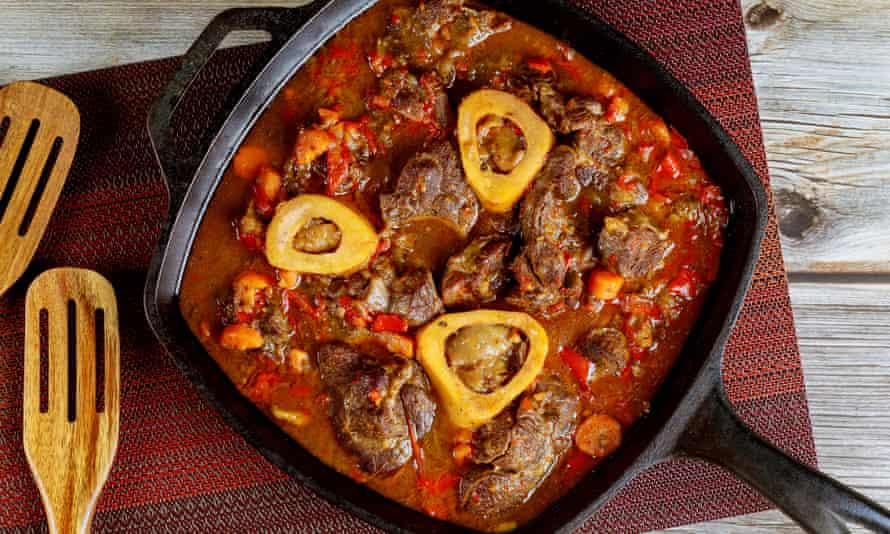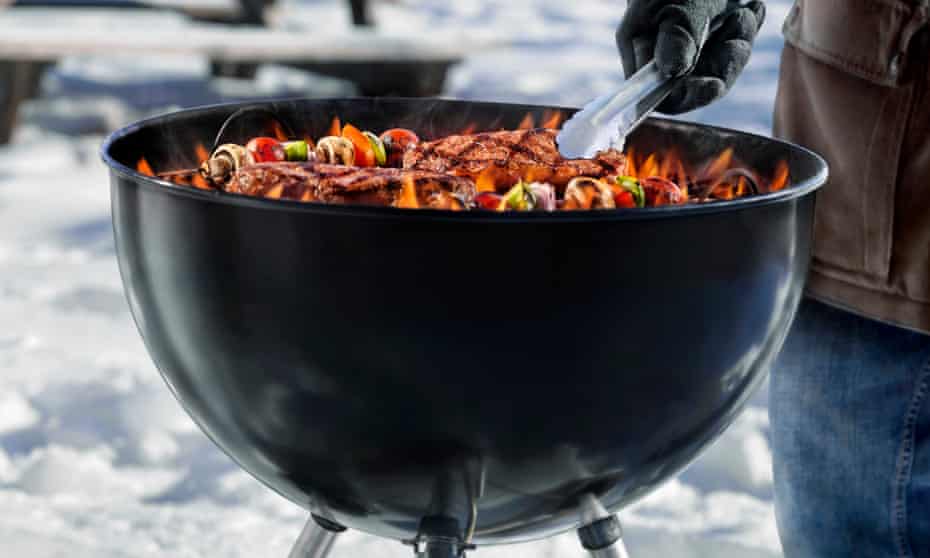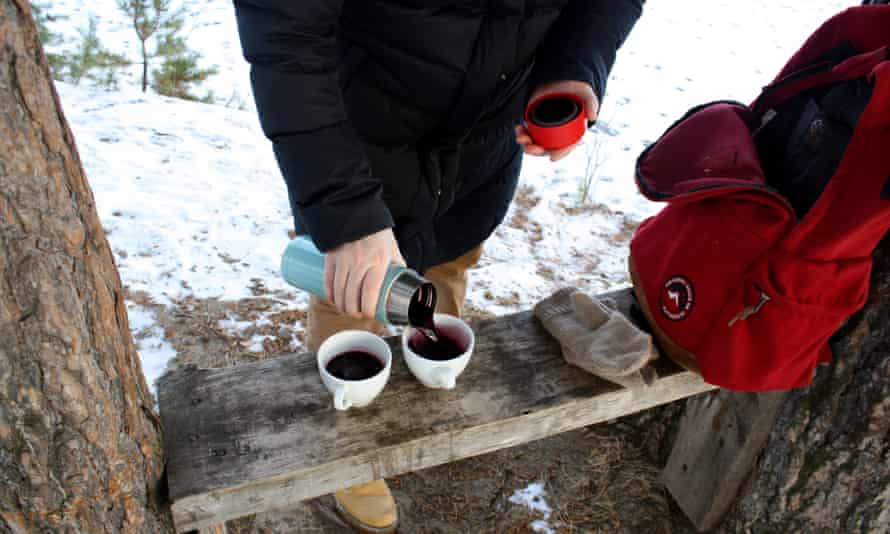In Siberia, barbecue season never stops, even in sub-zero temperatures. “We’d go out into the woods, clear the snow and have a party. It’s an amazing, elemental experience, being in nature around a fire,” recalls Alissa Timoshkina, a cookery writer raised in Omsk. “The key is to dress as you would when skiing: padded, layers, waterproofs.”
Partying in the woods is, of course, strictly forbidden during lockdown, but that sort of experience illustrates how – even if restricted to the back garden – Britain could embrace the winter barbecue. With restaurants closed, and even park picnics outlawed, a barbecue is one of the few ways to turn a household meal into a special occasion. And we’ve been buying the kit. Last year, thanks to lockdowns and social distancing, outdoor-heater sales were up 1,625% at John Lewis. The barbecue manufacturer Kamado Joe estimates its trade doubled around Black Friday, while Lakeland saw sales of its Cobb barbecue rise 240% in November, year on year.
Timoshkina is not alone in refusing to allow a little snow to stop a barbecue. Lithuanian-born Tomas Lidakevicius, now the executive chef at Turnips in Borough Market in London, remembers ice fishing with his grandad, and barbecuing mackerel on riverbanks, back when Lithuanian winters meant “snow up to the knees and -20C”.
Nina Matsunaga’s experience in Düsseldorf was less extreme, but, even in winter, her Japanese parents would bring huge seafood hauls back from the hypermarket and fire up the barbecue. “Scallops and clams wouldn’t make it to the fridge – we’d keep them on ice in the snow,” says Matsunaga, now the chef at the Black Bull hotel in Cumbria.
But what should we be eating when the skies are grey and the wind howls? “Anything spicy offsets cold, and gives you that fire inside,” says Timoshkina, the author of Salt & Time: Recipes from a Russian Kitchen. For example, shashlik kebabs wrapped in Armenian lavash flatbreads with home-fermented sides – sauerkraut, pickled cucumbers and the “super-punchy” horseradish and tomato sauce, khrenovina. “Ferments are simple, cheap and accessible, yet the flavours are so complex.”
Jackson Bristow, a live-fire chef at Nancarrow Farm near Truro in Cornwall, used to love heading off into the wild to barbecue in the open air. Even when in your own garden, he extols the benefits of packing stones together on freezing ground (to retain the heat) and building a fire: “With a barbecue, you can light it, lid on, go. Obviously, it’s easier. You have controllable airflow. But do you get as much fun from it? You’re warming yourself making a fire, and food always tastes better because it’s more effort to get to that point.”
Grappling with cold-weather barbecuing will, for most of us, be challenge enough. First, you will need a barbecue with a lid. Rain and fire do not mix; and wind is problematic, whether whipping up hotter flames, blowing out gas burners or misdirecting heat. “The minute you shut the barbecue lid,” says Bristow, “it’s a controlled environment.”
Gas pressure weakens significantly in cold weather, and you may need more charcoal than normal to create intense heat. “You’re going to have a harder time managing your temperatures,” says Martyn Lee, the executive chef at Waitrose, who always barbecues his Christmas turkey.
For these reasons, and because it is harder to keep and serve warm food in winter (tips include high-sided bowls; foil-wrapped, handheld food; stews and hot sandwiches), two methods of attack are advised. You either go early over the young flames, searing thin slices of meat over this rapid heat and eating straight from the fire. Or, a more popular option, you switch to longer, lower-temperature cooking of larger pieces of meat. This will need less oversight – no one has to watch the grill for hours. And larger pieces of meat will retain their heat better as they are carved.
“You’re treating the barbecue like an oven for slow-roasting and smoking,” says Lee. That is, using indirect or lower-temperature heat from shallow coal beds to slowly cook, for example, fatty, forgiving lamb shoulder or beef brisket over several hours. Experts tend to recommend heavy ceramic (and frequently expensive) kamado-style barbecues for low’n’slow cooking; Big Green Egg is the best known. “They’ve amazing heat retention and air vents that mean it’s possible to achieve smouldering 100C temperatures and lower for long periods,” says Jorge Thomas, co-founder of the meat supplier Swaledale.

Working with what you have is cheaper. Most stews, chillies and ragu dishes can be cooked on basic barbecues or started in a kitchen and finished outdoors, says Lee, to “get some smoke and charcoal-flavour through the sauce”. The Swedish open-fire chef Niklas Ekstedt recommends investing in cast-iron cookware: “If flames and heat are uneven, cast iron helps ensure things cook evenly.” Cast-iron pots also retain heat. Ideally, transfer the pot to a table where people can serve themselves. “Start splitting it up,” says Bristow, “and it’ll cool down quicker.”
Tightly wrap meat joints that need to rest in foil and a tea towel. If you can’t leave them in the kitchen, redeploy a cool-box. Lee says: “They’re insulating. Keep things warm in there using residual heat from foil-wrapped baked potatoes.” Stews can be held on a cooling barbecue.
Keeping everyone warm is also important. “I’d say winter barbecues need a barbecue and a firepit for warmth,” says Ali Ray, a food columnist for Camping and Caravanning magazine and the author of Pitch Up, Eat Local. Most firepits are basic metal bowls that sit on a stand, although you can buy larger pits that include hinged or hanging grills. Pieces for Places in North Wales has some from £185.
Not that Ray is splurging on accessories. She keeps old blankets handy, has been known to use a hot-water bottle (“It was 4C; everybody was very jealous”) and favours layering: “Thermals or tights under jeans and always a hat. That’ll be your saving grace.”
Ray’s husband, an outdoor swimmer, has even worn his wetsuit to a winter barbecue. “He was last man standing,” she laughs. “Among friends, it doesn’t matter.”

Barbecue dishes for wintry outdoor dining
Lamb shoulder broth Lee says lamb shoulder (“rubbed with curry paste”) is one of those big, fatty cuts that is largely self-managing. You’ll just need to periodically top up the charcoal and manage the vents to sustain 120-140C for four to five hours; a temperature probe can make this simpler but is not essential. This also works with pork shoulder: “I like a simple, almost Spanish rub using garlic, smoked paprika, rosemary, olive oil and tomato paste.”
Let the meat rest, then shred it over rice or into a suitable pulse and vegetable broth. “Keep it in a Thermos and just pour it into bowls with the meat.”
Beef shin stew Sear 2cm-thick rounds of beef shin on the grill – 1kg (2.2lb) serves six-plus. Using a Le Creuset-style cast-iron pot (“Like a pan on the stove,” says Bristow), sweat herbs, onion and garlic, adding the shin, tomato puree and red wine, topped with beef stock. Cook on a closed barbecue for two to three hours, at about 140C. “It’s tough muscle, but eventually shin will break up by itself. It tells you when it’s ready and, with all that liquor, it won’t dry out.”
Serve with crispy jacket spuds that have been oiled, salted, foil-wrapped and cooked directly in the embers, a process which, over an hour or two, works with other vegetables, from celeriac to beetroot. Use a skewer to test doneness. “They’re not,” notes Bristow, “cooling down in a hurry.”
Thai spatchcock chicken “My go-to barbecue marinade is: lots of garlic, coriander root, lemongrass, white pepper, all pounded together. Add soy to round it out and a little sugar to help caramelise the meat,” says Sai Deethwa, the chef-owner at the West Midlands street-food outfit Buddha Belly. Deethwa’s preferred chilli dipping sauce (two tbsp soy sauce; one tbsp lemon juice; chopped coriander stalks; one tsp toasted, ground rice; pinch of sugar; one tbsp ground, roasted birdseye chilli) will, similarly, bring a rosy glow to frozen cheeks.
Barbecue mushroom flatbreads The Little Chartroom in Edinburgh has a barbecue shack on Portobello beach, and its chef, Roberta Hall-McCarron, cooks oiled, seasoned mushrooms in a sieve on the grill: “They don’t stick, but you get those barbecue flavours. We do a barbecue mushroom flatbread with black garlic mayo and crispy potatoes and, oh my God, it’s good. We always have barbecued oysters on, too. Put the oyster on the grill and when it’s ready, it pops open.”
Whole, coal-roasted vegetables “You can cook leeks and onions in their skins in the coals, turning them every 20 minutes until tender,” says Neil Campbell, the chef at Rovi in London. “Take the crust off red onions, dress with sherry vinegar, pomegranate molasses and fennel seeds, and that’s a lovely warm salad with lamb. Cabbage is another great one. Take the outer leaves off and cook it in coals until soft, turning every 30 minutes [over about 90 minutes].” Then sear sections of the cabbage on the barbecue and dress it with bacon, chestnuts and barbecued onions fried in butter.
Pumpkin bowls “I love to cut pumpkins in half, scoop out the seeds and create two bowls,” says Lidakevicius. Fill the cavity with diced onion, cooked streaky bacon, garlic, herbs, salt and oil, cover with foil and cook the pumpkins pressed into the coals until soft (45 minutes, depending on skin toughness). “The insides all stew until you can scoop it all out. A simple, perfect warming meal.”
Ghanaian domedo pork shoulder “Like pulled pork, domedo can be eaten on its own or with bread or rice,” says Aji Akokomi, the founder of Akoko restaurant in London. Create a marinade paste (three tbsp paprika; three garlic cloves; one tbsp chilli powder; two tbsp brown sugar; one tbsp black pepper; two tbsp salt; grapeseed oil), and “very generously” rub the shoulder. Once the barbecue is at 200C, start grilling, lid closed, spraying the shoulder with a pork stock every 30 minutes. After two hours, spray it again, wrap the shoulder in foil and reduce the temperature to 140C. Cook for three hours. The shoulder should reach 93C internally (check using a meat thermometer). Allow it to rest for an hour before serving.

Hot drinks for warming winter quaffing
Jack Wakelin, the drinks expert at Bench in Sheffield (currently operating as an online wine shop, deli and kebab takeaway) favours hot cocktails, such as mulled cider and wine (use tempranillo as a neutral base) that can be carried and kept warm in a Thermos. If you don’t drink alcohol, swap apple juice for cider or a mixture of pomegranate and cranberry juice for wine (“with just a little drop of red wine vinegar for tartness”, suggests Wakelin) before warming them with your preferred fruits and mulling spices. You could even use blackcurrant cordial.
Wakelin’s favourite hot cocktail is spiced, buttered brandy. For four people, combine 600ml of damson brandy or sloe gin with 400ml water, the zest and juice of two oranges, eight cloves, two star anise, two tbsp of ground cinnamon, two bay leaves and two teaspoons of agave syrup. Slowly heat the mixture without letting it boil before sieving it into a flask. Add a knob of butter to each mug before serving.
Hot toddies are easily transported, too. For each person, bring 125ml of water to a quick simmer (with optional ginger, star anise, a few cloves, cinnamon stick), then, off the heat, add honey, lemon juice and 50ml of whisky. Pour that into a flask, giving it a good swirl before serving.
Wakelin also suggests adding a splash of chocolate liqueur (he likes Sheffield’s own Bullion Cocoa Nib), to good coffee in lieu of sugar or spiking generic hot chocolate with “a heavy pinch of salt” and – this will appal single malt purists – Talisker 10 whisky: “Its salinity and peaty character is perfect for bonfires.” For the kids, drop the booze, but add barbecued marshmallows, as Hall-McCarron does at her Edinburgh Little Chartroom barbecue shack: “It’s ridiculous how many we sell.”




